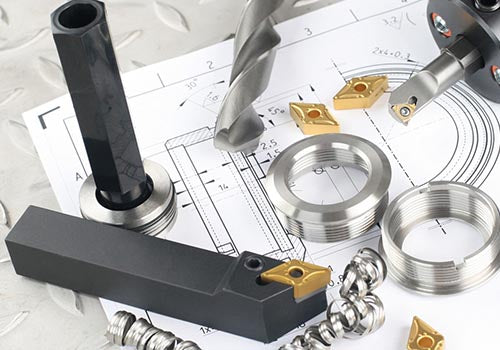
The Significance of CNC Inserts in Creating Quality Products
Share
In the manufacturing industry, the use of CNC machines has revolutionized the way we produce products. These machines have enabled us to make products with high accuracy, precision, and consistency. Among the essential components of these machines are CNC inserts. CNC inserts are replaceable cutting tips that are used in CNC machines to cut, shape, and finish materials such as metals, plastics, and woods. They play a critical role in determining the quality of the final product.
In this blog post, we will explore the significance of CNC inserts in creating quality products. We will look at the different types of CNC inserts, their properties, and how they influence the cutting process. We will also discuss the factors to consider when choosing CNC inserts and the benefits of using them in CNC machines.
Types of CNC Inserts
CNC inserts come in different shapes, sizes, and materials. The most common types of CNC inserts include:
Carbide Inserts
Carbide inserts are made of tungsten carbide, a hard and durable material that can withstand high temperatures and pressures. They are ideal for cutting hard materials such as steel, iron, and titanium. Carbide inserts have excellent wear resistance, which makes them last longer than other types of inserts. They are also suitable for high-speed cutting, which means they can cut materials faster than other inserts.
Ceramic Inserts
Ceramic inserts are made of ceramic materials such as alumina and silicon nitride. They are ideal for cutting high-temperature materials such as cast iron, stainless steel, and nickel-based alloys. Ceramic inserts have high hardness and excellent thermal shock resistance, which means they can withstand high temperatures without breaking or cracking. They are also suitable for high-speed cutting, which means they can cut materials faster than other inserts.
Diamond Inserts
Diamond inserts are made of synthetic or natural diamond particles. They are ideal for cutting non-ferrous materials such as aluminum, copper, and brass. Diamond inserts have high hardness and wear resistance, which means they can last longer than other inserts. They are also suitable for high-speed cutting, which means they can cut materials faster than other inserts.
Properties of CNC Inserts
CNC inserts have different properties that determine their cutting performance. These properties include:
Cutting Edge Geometry
The cutting edge geometry of CNC inserts determines the shape and size of the material being cut. Different cutting edge geometries are suitable for different materials and cutting conditions. For example, sharp cutting edges are suitable for soft materials, while rounded cutting edges are suitable for hard materials.
Tool Coating
Tool coating is a thin layer of material that is applied to the surface of CNC inserts. It improves the wear resistance and reduces the friction between the insert and the material being cut. Different types of coatings are suitable for different materials and cutting conditions. For example, titanium nitride (TiN) coating is suitable for cutting steel, while diamond-like carbon (DLC) coating is suitable for cutting aluminum.
Insert Material
The material used to make CNC inserts determines their hardness, toughness, and wear resistance. Different materials are suitable for different materials and cutting conditions. For example, carbide inserts are suitable for cutting hard materials such as steel, while ceramic inserts are suitable for cutting high-temperature materials such as cast iron.
Factors to Consider When Choosing CNC Inserts
Choosing the right CNC inserts is critical to achieving high-quality products. The following are the factors to consider when choosing CNC inserts:
Material Being Cut
Different materials require different types of CNC inserts. For example, hard materials such as steel require carbide inserts, while high-temperature materials such as cast iron require ceramic inserts.
Cutting Speed
The cutting speed determines the type of CNC insert to use. For example, high-speed cutting requires carbide or ceramic inserts, while low-speed cutting requires diamond inserts.
Cutting Depth
The cutting depth determines the shape and size of the material being cut. Different types of CNC inserts are suitable for different cutting depths. For example, sharp cutting edges are suitable for shallow cutting, while rounded cutting edges are suitable for deep cutting.
Cutting Environment
The cutting environment determines the type of coating to use. For example, a dry cutting environment requires a TiN coating, while a wet cutting environment requires a TiCN coating.
Benefits of Using CNC Inserts
Using CNC inserts in CNC machines has several benefits, including:
High Accuracy and Precision
CNC inserts enable CNC machines to cut materials with high accuracy and precision, which means the final product is of high quality.
Consistency
CNC inserts ensure that the cutting process is consistent, which means the final product is of uniform quality.
Cost-Effective
CNC inserts are replaceable, which means they can be replaced when worn out. This makes them cost-effective compared to solid cutting tools.
Reduced Downtime
CNC inserts can be replaced quickly, which means downtime is reduced. This increases productivity and reduces production costs.
Conclusion
CNC inserts play a critical role in creating quality products in the manufacturing industry. They come in different types, shapes, and sizes, and have different properties that determine their cutting performance. Choosing the right CNC inserts is critical to achieving high-quality products. Using CNC inserts in CNC machines has several benefits, including high accuracy and precision, consistency, cost-effectiveness, and reduced downtime. As technology continues to evolve, CNC inserts will continue to play a critical role in creating quality products.




